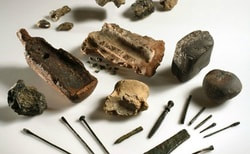 The Earliest Settlement in Aegean Region 0,7 miles diameter wide Cukurici Hoyuk (Mound) is located on the southeast part of Ephesus Ancient city, in a very lush plain surrounded with orchards. The excavations directing that this hillside is dating back to prehistoric periods. And during 1000 years of time, it was settled continuously. Large settlement segments are accumulated in Cukurici Hoyuk. Such settlements are typical from East and Southeast to Europe during both Neolithic and Bronze Ages ( 8th to 2nd Millennium BC.) And in Western Turkey (Western Anatolia) only few of them systematically studied. So far there have been 5 different settlement layers are excavated in Cukurici Hoyuk, which are dating to different periods of time and are in different scales. This case brings up an overture to the age of Cukurici Hoyuk. The Importance of Cukurici Hoyuk Excavations of Cukurici Hoyuk enlightened the oldest settlement at Ephesus starting from 8200 BC. The studies held so far showes that Cukurici Hoyuk is the oldest settlement. Another geological exploratory drilling made in the slopes of the hillside shows that there may be older settlements. Researching about the expansion of the Neolithic Age lifestyle in Anatolia and Southeast Europe is just covering one aspect of the remarkable issues. The cultural changes in 4th Millenium BC. launched another Age, Early Bronze Age. Cukurici Hoyuk presents significant data to understand the permanent changes of Early Bronze Age and Early 3rd Millennium BC. The function of Cukurici Hoyuk is still not know in the Early Bronze Age, there are still bunch of questions waiting for the answers, which requires a profound study and research. Cukurici Hoyuk is located between Anatolia and Aegean Region Cultures. There are very strong and comprehensive boundaries and relations between these 2 cultures and it is impossible to reckon any remarkable improvement and change for the Prehistoric mankind without taking these relations into consideration. The History of Cukurici Hoyuk At the end of the 7th Millenium BC (Late Neolithic / Early Calcholithic Age) Cukurici Hoyuk was used as an inhabitancy; the residents with stone basements and mud-brick walls proves that there was settled population over here in Cukurici Hoyuk. In this early phase the food is variable. Firstly wild boar, goat, sheep and cattle were domesticated species. However hunting of rabbit, fox, deer, ox and also mussel collecting are means of food consumption. The production of the high quality ceramic cups, stone gadgets, and generally imported obsidian stone gadgets proves that, the resident people of Cukurici Hoyuk were aware of the technology. There is a destruction and corruption caused by a reason which is still unknown led this early settlement Cukurici Hoyuk to be forsaken. It is known that after the 7th Millennium BC, the first period coming up is 1500 years later 4th Millennium BC. Starting with 4th Millennium BC. there has been a continuous settlement until 2500 BC and in early Bronze Age, Cukurici Hoyuk was abandoned for the 2nd time. In Early Bronze Age there were quite significant and permanent changes experienced in Aegean Region and southeast Europe. By the amendment of the metals and the merchandising of the metal goods, people started getting wealthier. Literally the trade and the wealth put the first Proto-Urban cities on the map. At this very important point of the improvement of the Prehistoric mankind, the role of Western Anatolia (West Turkey) is still uncertain. In this very moment in Cukurici Hoyuk there have been mud-brick walled , gigantic stone based and multi room residential units built. This period of settlements were fatally destructed by an earthquake and have never been built again. The small findings in this area indicates that there is a very remarkable and numerous vivid efficiency in Cukurici Hoyuk. Especially the important point is the production of the copper items: In the process of such products, it is known that the items were formed in the moulds then final shapes were given by hammering. Compared to the previous population, there is a change observed in the consumption habits of the people. In Cukurici Hoyuk, rabbit, fox, wild-boar, deer and fox, bear and various species of birds were hunted animals, while the sheep and goats were domesticated. Cukurici Hoyuk and it's Environment To research about the micro-regional environment of Cukurici Hoyuk, the reconstruction of the Pre-historic region, the exact coastal line, ecological resources and climate conditions are being studied. In the excavation team of Cukurici Hoyuk, there are scientists actively working since 2007 from the fields of Archaeology, Archaeozoology, Archaeobotany, Anthropology, Climatology, Physics, Paleogeography, Geology and Mineralogy. Resource: Translated into English by Tugrul Sokmen from the original Booklet of Austria Archaeology Institute / Ephesus Excavations 2009 /www.oeai.at Original Text: B.Horejs Turkish Translation: Filiz Ozturk |
